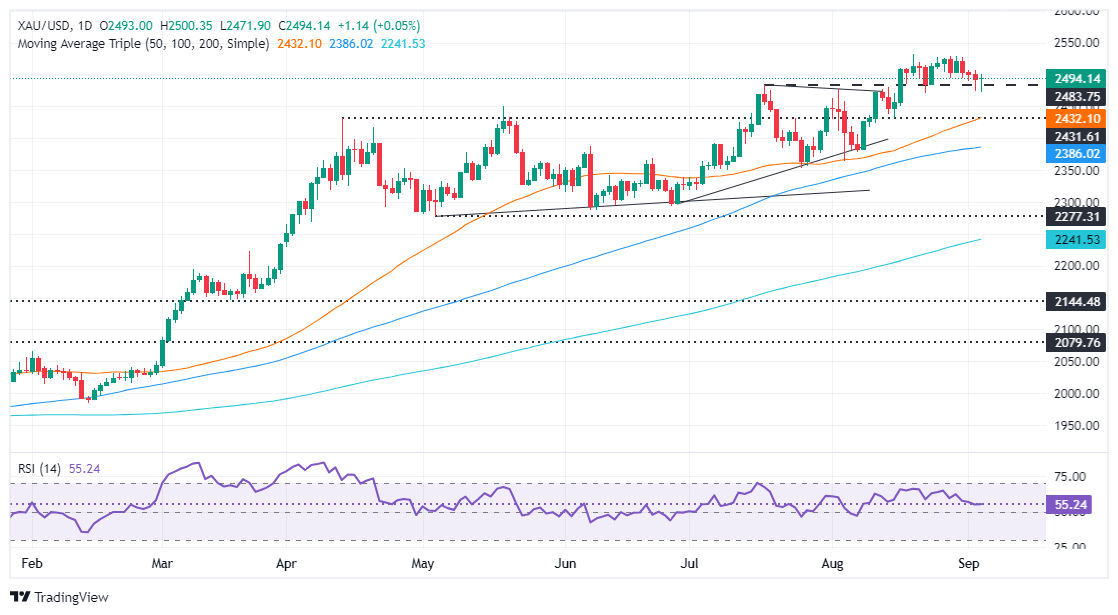- XAU/USD is up 0.05% at $2,493, with prices rebounding after touching a daily low of $2,471.
- A weaker-than-expected US JOLTS report fuels speculation of a 50bp Fed rate cut in September.
- Falling US Treasury yields and a weaker US Dollar support Gold, despite volatile profit-taking throughout the session.
Gold prices edged higher during the North American session after weaker-than-expected jobs data in the United States (US) raised the odds of a 50 basis point (bp) rate cut by the Federal Reserve. Moreover, US Treasury bond yields fell and undermined the Dollar, which is inversely correlated with the golden metal. Thus, XAU/USD is trading at $2,493, up a minimal 0.05%.
Bullion prices had been swinging throughout the day, driven mainly by profit-taking by traders, which pushed the yellow metal towards a daily low of $2,471. Lately, Gold regained some ground as the US Bureau of Labor Statistics (BLS) revealed its latest Job Openings and Labor Turnover Survey (JOLTS), showing that job openings fell to their lowest level since January 2021.
Following the data, US Treasury yields fell, as shown by the yield on the benchmark 10-year note, which fell nearly six bps to 3.776%, as traders increased their bets that the Fed could cut interest rates aggressively on fears that they are lagging behind.
According to CME FedWatch data, the odds of a 50bp cut at the September meeting have risen to 43%, almost a toss-up, as the next Federal Open Market Committee (FOMC) meeting is scheduled for September 17-18.
The US Dollar Index (DXY), which tracks the performance of six currencies against the US dollar, fell 0.37% to 101.38 after recovering from a yearly low and was up nearly 1.30% over the past six days.
Market sentiment remains negative, blamed on a rotation out of stocks amid fears of a US recession. On the geopolitical front, the narrative remains slightly calm amid talks of a ceasefire in the Israel-Hamas conflict, while Russia’s invasion of Ukraine continues.
Meanwhile, gold traders are bracing for another round of US employment data, with the ADP National Employment Change report, Initial Jobless Claims and the Non-Farm Payrolls (NFP) report due.
Daily Market Drivers Roundup: Gold Price Traders Await Busy US Economic Calendar
- The US BLS revealed that the number of job openings in July plummeted compared to the downwardly revised data from June via the JOLTS report. Vacancies fell from 7.910 million to 7.673 million.
- In other data, July factory orders beat estimates by 4.7%, rose sharply to 5% and flattened June’s contraction of -3.3%.
- U.S. business activity in the manufacturing sector improved but remained in contraction territory.
- Private hiring, as revealed by ADP’s National Employment Change report, is projected to rise from 122,000 in July to 150,000 in August.
- August NFP figures are expected to rise from 114,000 to 163,000, while the unemployment rate could decline, according to consensus, from 4.3% to 4.2%.
- The Chicago Board of Trade (CBOT) December 2024 federal funds rate futures contract suggests investors are looking at 106 basis points of Fed easing this year.
Technical Outlook: Gold Price Hovering Around $2,500
Gold price’s uptrend resumed on Wednesday as a ‘tweezers bottom’ chart pattern emerged, but buyers need to overcome a key resistance level that could sponsor a retest of the yearly high. Momentum, as measured by the Relative Strength Index (RSI), hints that buyers are in charge but remained flat in the near term.
If buyers manage a daily close above $2,500, the next resistance would be the all-time high (ATH) at $2,531, followed by the $2,550 mark. A break of the latter will expose $2,600.
Conversely, if XAU/USD sustains below $2,500, the next support would be the August 22 low at $2,470. Once overcome, the next demand zone would be the confluence of the April 12 high turned support and the 50-day simple moving average (SMA) around $2,431.
Gold FAQs
Gold has played a pivotal role in human history as it has been widely used as a store of value and a medium of exchange. Today, apart from its luster and use for jewelry, the precious metal is considered a safe haven asset, meaning it is considered a good investment in turbulent times. Gold is also considered a hedge against inflation and currency depreciation as it is not dependent on any particular issuer or government.
Central banks are the largest holders of gold. In their aim to support their currencies in turbulent times, central banks tend to diversify their reserves and buy gold to improve the perception of the strength of the economy and the currency. High gold reserves can be a source of confidence in a country’s solvency. Central banks added 1,136 tonnes of gold worth about $70 billion to their reserves in 2022, according to data from the World Gold Council. This is the largest annual purchase on record. Central banks in emerging economies such as China, India and Turkey are rapidly increasing their gold reserves.
Gold has an inverse correlation with the US Dollar and US Treasury bonds, which are the main reserve and safe haven assets. When the Dollar depreciates, the price of Gold tends to rise, allowing investors and central banks to diversify their assets in turbulent times. Gold is also inversely correlated with risk assets. A rally in the stock market tends to weaken the price of Gold, while sell-offs in riskier markets tend to favor the precious metal.
Gold prices can move due to a wide range of factors. Geopolitical instability or fears of a deep recession can cause the price of Gold to rise rapidly due to its status as a safe haven asset. As a non-yielding asset, Gold prices tend to rise when interest rates fall, while rising money prices often weigh down the yellow metal. Still, most of the moves depend on how the US Dollar (USD) performs, as the asset is priced in dollars (XAU/USD). A strong Dollar tends to keep Gold prices in check, while a weaker Dollar is likely to push Gold prices higher.
Source: Fx Street
I am Joshua Winder, a senior-level journalist and editor at World Stock Market. I specialize in covering news related to the stock market and economic trends. With more than 8 years of experience in this field, I have become an expert in financial reporting.








